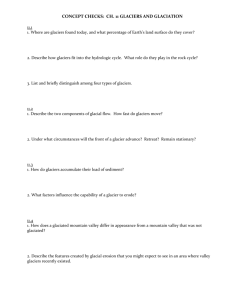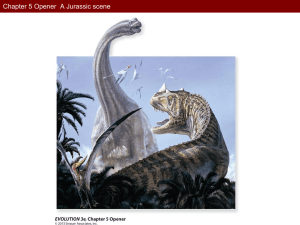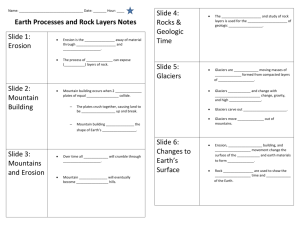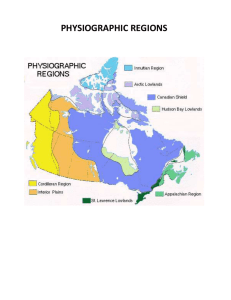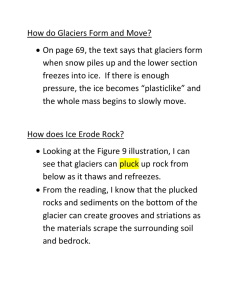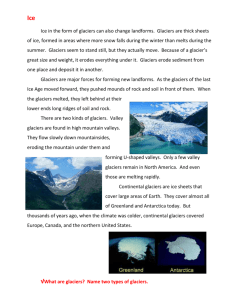WS Ch 17 Objectives and Summaries
advertisement
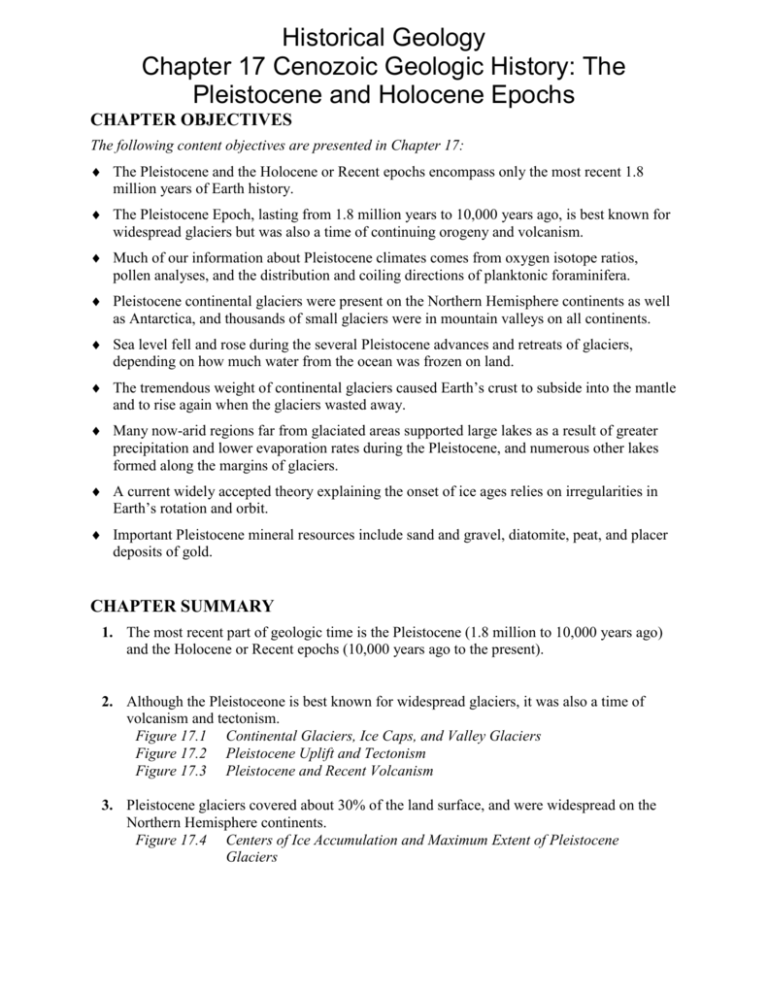
Historical Geology Chapter 17 Cenozoic Geologic History: The Pleistocene and Holocene Epochs CHAPTER OBJECTIVES The following content objectives are presented in Chapter 17: The Pleistocene and the Holocene or Recent epochs encompass only the most recent 1.8 million years of Earth history. The Pleistocene Epoch, lasting from 1.8 million years to 10,000 years ago, is best known for widespread glaciers but was also a time of continuing orogeny and volcanism. Much of our information about Pleistocene climates comes from oxygen isotope ratios, pollen analyses, and the distribution and coiling directions of planktonic foraminifera. Pleistocene continental glaciers were present on the Northern Hemisphere continents as well as Antarctica, and thousands of small glaciers were in mountain valleys on all continents. Sea level fell and rose during the several Pleistocene advances and retreats of glaciers, depending on how much water from the ocean was frozen on land. The tremendous weight of continental glaciers caused Earth’s crust to subside into the mantle and to rise again when the glaciers wasted away. Many now-arid regions far from glaciated areas supported large lakes as a result of greater precipitation and lower evaporation rates during the Pleistocene, and numerous other lakes formed along the margins of glaciers. A current widely accepted theory explaining the onset of ice ages relies on irregularities in Earth’s rotation and orbit. Important Pleistocene mineral resources include sand and gravel, diatomite, peat, and placer deposits of gold. CHAPTER SUMMARY 1. The most recent part of geologic time is the Pleistocene (1.8 million to 10,000 years ago) and the Holocene or Recent epochs (10,000 years ago to the present). 2. Although the Pleistoceone is best known for widespread glaciers, it was also a time of volcanism and tectonism. Figure 17.1 Continental Glaciers, Ice Caps, and Valley Glaciers Figure 17.2 Pleistocene Uplift and Tectonism Figure 17.3 Pleistocene and Recent Volcanism 3. Pleistocene glaciers covered about 30% of the land surface, and were widespread on the Northern Hemisphere continents. Figure 17.4 Centers of Ice Accumulation and Maximum Extent of Pleistocene Glaciers Historical Geology Chapter 17 Cenozoic Geologic History: The Pleistocene and Holocene Epochs 4. At least four intervals of extensive Pleistocene glaciation took place in North America, each separated by interglacial stages. Fossils and oxygen isotope data indicate about 20 warm-cold cycles occurred during the Pleistocene. Figure 17.5 Pleistocene Glaciers in North America Figure 17.6 Climatic Changes During the Cenozoic Figure 17.7 Pollen Analysis and Climate 5. Areas far beyond the ice were affected by Pleistocene glaciers: Climate belts were compressed toward the equator, large pluvial lakes existed in what are now arid regions, and sea level was as much as 130 m lower than now. Figure 17.8 The Greenland Ice Sheet Figure 17.9 Erosion by Continental and Valley Glaciers Yields Distinctive Landscapes 6. Moraines, striations, outwash, and various other glacial landforms are found throughout Canada, in the northern tier of states, and in many mountain ranges where valley glaciers are present. Figure 17.10 Origin of End Moraines and Outwash Figure 17.11 Terminal and Recessional Moraines in the Mid-Continent Region Figure 17.12 The Geologic Evolution of Cape Cod, Massachusetts, and Nearby Areas During the Ice Age Figure 17.13 The Bering Land Bridge 7. The tremendous weight of Pleistocene glaciers caused isostatic subsidence of Earth’s crust. When the glaciers melted, isostatic rebound began and continues even now in some areas. Figure 17.14 Glaciers and Isostasy 8. During times of ice accumulation, large pluvial lakes existed in now arid areas because of greater precipitation and overall cooler temperatures, which lowered the evaporation rate. In contrast to pluvial lakes, which formed far from the areas of glaciation, proglacial lakes form where meltwater accumulates along a glacier’s margin. The Great Lakes formed when advancing glaciers deeply eroded the area. As the glaciers melted and retreated, the lakes formed with water. Figure 17.15 Pleistocene Lakes in the Western United States Figure 17.16 Glacial Lake Missoula was a Proglacial Lake, Whereas Lake Bonneville was a Pluvial Lake Figure 17.17 Four Stages in the Evolution of the Great Lakes 9. Major glacial intervals separated by tens or hundreds of millions of years probably stem from changing positions of plates, which in turn profoundly affect oceanic and atmospheric circulation patterns. 10. According to the Milankovitch theory, minor changes in Earth’s rotation and orbit bring about climatic changes that produce glacial-interglacial intervals. Figure 17.18 According to the Milankovitch Theory, Minor Irregularities in Earth’s Rotation and Orbit May Affect Climatic Changes Historical Geology Chapter 17 Cenozoic Geologic History: The Pleistocene and Holocene Epochs 11. The causes of short-term climatic changes such as occurred during the Little Ice Age are unknown; two proposed causes are variations in the amount of solar energy and volcanism. Figure 17.19 Glaciers in the Cascade Range Enrichment Topic 2. The CO2 Culprit For many years, researchers have questioned whether humans will have a major impact on climate change. It has long been proposed that rising carbon dioxide levels will cause global warming, and these increased CO2 levels are attributed to the Industrial Revolution and the burning of fossil fuels. However, some scientists offered rebuttals about the impact of humans on CO2 levels, as well as the role that humans play in CO2 production. (“The Holocene CO2 Rise: Antropogenic or Natural?” Eos, Jan. 2006, v.87 n.3 p.27.) Several researchers (Royer, Berner, Montanez, Tabor, and Beerling) reviewed geologic records of CO2 and glaciations and demonstrated that CO2 was low (<500 ppm) during periods of continental glaciation, and higher (>1000 ppm) during warmer periods. (“CO2 as a Primary Driver of Phanerozoic Climate,” GSA Today, March 2004 v.14 n.3 p.4-10) It is predicted by some geologists that twice the CO2 level will exist in the atmosphere by 2100. (“No Easy Way Out of the Greenhouse,” Discover, Oct. 2005, v.26 n.10 p.30-31) If the global warming predictions are correct, then humans could possible suffer adverse health effects, including increase in asthma and respiratory ailments, and heat-wave related deaths. (Perkins, “Dead Heat: The Health Consequences of Global Warming Could Be Many,” Science News, July 3, 2004, v.166 n.1 p.10-12) Enrichment Topic 3. Could Global Warming Start a Little Ice Age in Europe? Oddly, global warming could bring about a new ice age in Europe. Europe is warmer than it should be for its latitude. Warm water from the equator travels up North America, and then the Gulf Stream moves eastward across the Atlantic, then south down the European coast. The heat stored in these waters warms Europe. Global ocean circulation is driven by the sinking of cold, dense water in the north Atlantic. If air temperature warms so much that sea surface temperatures do not cool the North Atlantic waters sufficiently, they will remain on the surface instead of sinking. This will shut down ocean circulation, including the Gulf Stream. USA Today (Magazine), June 2002 v.130 n.2685 p.8(2). Enrichment Topic 4. Slight Changes in Climate May Trigger Abrupt Ecosystem Responses The U.S. Geological Survey assessed the implications that a warming Earth would have on North American ecological thresholds. An ecological threshold is the point at which large changes occur that are potentially irreversible. Some of the implications adversely affect humans, including forest dieback, wildfire, and insect infestations. Humans can also increase an ecosystem’s potential for reaching the threshold, including water use in an area that is affected by drought. Although not enough is known about ecological thresholds, researchers stated that ecosystems will differ significantly. The Environmental Protection Agency, Synthesis and Assessment Product 4.2: Thesholds of Climate Change in Ecosystems, http://climatescience.gov Forest dieback has also been intensely studied. The death rates of trees in US western forests have doubled over the past 20-30 years. The U.S. Geological Survey attributed the die-back to higher temperatures as well as water scarcity. The scientists warned that if the current rate of tree mortality continues, or accelerates, the U.S. forests “could shift from being a carbon sink that Historical Geology Chapter 17 Cenozoic Geologic History: The Pleistocene and Holocene Epochs takes greenhouse gases out of the atmosphere to becoming a net emitter of carbon dioxide.” Eilperin, “Study Ties Tree Deaths to Change in Climate,” The New York Times, January 23, 2009 12. Pleistocene mineral resources include sand and gravel, placer deposits of gold, and some evaporite minerals such as borax.
